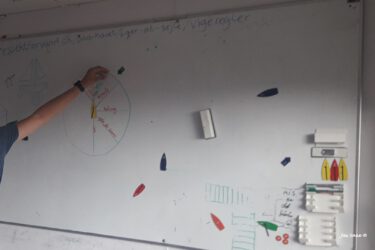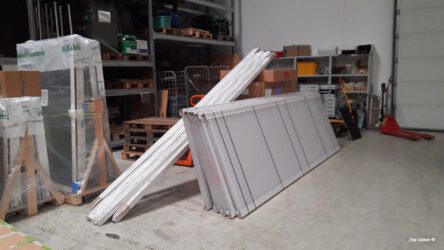Visiting lots of garages and workshops during my life or watching episodes of Homestead Rescue one thing is obvious: Either you get things done at the right time, at the right price, in the right quality and deliver the right amount the right place.
Or you don’t!
Why this difference? And how do you change it to the better instantly?
Being a skilled craftsman and manager with practical experience for years I can give you some easy tips for turning that part of your life into success and get the job done.
What seems to be general common denominator is more or less something like this:
When it doesn’t work I often recognize:
- mess on the scene or location,
- lots of garbage,
- no structure,
- no plans or “only In my head plans”,
- no common visible goal(s),
- nearly chaos,
- bad and poor maintained tools
- no security,
- stuck in old feelings,
- poor or no environmental handling,
- no or poor technical, management or economic skills,
- poor or no knowledge of what you actually doing,
- and no standard procedures or road maps of how to reach your dreams or vision.
Many workshops or projects at a homestead killed themselves due to lack of economic control, time control, administration control, environmental control, rejection to changes, staff control, denial of reality, or just simple management and welfare of yourself and your people. Add to this poor marketing to promote or sell your service or products.
If you can say yes to one or more of this disorder I can help you here.
It’s not like a magic wand from Harry Potter sorting all the mess but spending a bit of time in structured planning and management comes very good back. Keep stick to my Standard Five Bullets International Approved Working Structure and lets keep it simple:
1) Get your situation?
2) What is the task?
3) How to do it and carry it out?
4) Use and help of Logistic?
5) How do you Communication?

Asking and planing by those 5 items and following the structure can bring you into success. I will dig into the items and explain the five bullets:
ad 1) The situation
Ask yourself: What is the situation? This is managing and controlling your dream of your small workshop or homestead.
What is the easy going, what’s the obstacle, who can help you when? When does it have to be finished? Working on projects as it is – are always a race against time, and the more you are in management the that the better you can resist unforeseen obstacles that always comes.
Make a sketch, a simple drawing, something that visualize and tells your idea(s). Both for your own mind and memory, but mostly for others to see what you are aiming for. This way people remember things better than they do just by listening. In short, people remember about 15-25 % of what they hear, about 25 % of what they see, and in total something about 50 % by putting the same audio (your speak) and visible (your drawings) message together. Showing and explaining is the easy quick win.
If you don’t know the situation, you don’t know how to reach your goals.
When you all in your workshop, small factory, farm or homestead knows the target you are also much more likely you got the bullets on the right circle. And as everyone know the situation you can even take a day off or two during the week and with peace in mind knowing you still going forward on the right track
You might consider a SWOT-analyses to help you.
If you are working outdoor, daylight is a factor to be taken into your plans.
Also these questions should by asked and answered:
- When is administrative deadlines?
- When is practical deadlines as workforce and weather?
- What’s the economic situation?
Pay big attention here – otherwise your ideas and project are soon doomed.
When do you have to pay the bills and where to get the money from without robbing a back or stealing? Do daily accounting and economic control not matter how much you don’t like it! - Where ca you get most value of your money? Buying second can be a big saver.
- What is the environmental situation and regulations?
- What is the power, plumbing, sewing, cutting, welding noise, regulations?
- And when you know this you can also ask how to solve it navigate safer between it.
And saying “I don’t need to know any that” … I just say -Welcome to Mother Earth and a the civilization. All these elements are influencing as your stakeholders no matter you like them or not. Don’t consider them as enemies but elements for cooperation.
It can also be used for making you primary carry out plan later. And secondary plan — or plan C or plan D … or Plan …
The more you and your helpers knows about the situation the better you manage and reach your goals. Not all needs to be transfers to your helpers. A foreman of left hand of you, can be fine.
Situation is also everything about time and schedules.
- A “simple” timeline goes here:a) is the calendar and major scheduler of the whole project.
Deadlines of all kind should go here: Payment of bills, last day sending applies for the authoress, all working staff available, birthdays, holidays etc, last working day, first working day. - Other information: like the weather, the opening hours of the dump, petrol station, railway, roads …
- a call in an A-line as in bullet 3 you will have B-line for the daily tasks.
Not everything can be answered and some answers are the same as yesterday and the day before yesterday. When so, you can easily say in your instruction; no news.
ad 2) What is the task(s)?
What is goal, how good do you want it?
When do you want it finished? What is the deadline? What is the working or duration hours.
What are need to done and what are nice to do?
Cut off the nice things if lack of hours. Sometimes functionality comes over design. But keeping design good also keeps the end goal good.
How many people do you need to assign to reach this?
This requires a bit planning and finding the logical structure of the tasks your working with.
If you building houses making first floor will not be task before the foundation and base is ready. And before that you need the permission from the local authorities to start rebuilding.
You might place all the jobs to be done on white board or small notes on pages in a leaflet.
For the start of sorting I often just use pen and papers. No need for IT her, but free IT-tools available in my Raspberry Pi Libre Office and Freedombox section. Using a simple spreadsheet can makes miracles. Both economy, tasks and account is possible here.
Consider a Gant-diagram or mind map as tool.
ad 3) How to do it? – the carry out?
This were your instructions is all about how you actual get things done and carry out and instruct others to help you. Remember friends and family might not have same education nor experience as you, and might even not share your vision. So spending time here comes return in good value. What want to obtain is make people work independently without have to supervise them all the time.
- First the overall task of what to be done. The big pictures of manøvres and tasks.
- Than task for teams.
- Tasks for single people and
- Tasks for specialist.
If possible let people work in teams. They might inspire and help echa other, getting good memories for later but also important, in case of emergency helping each other.
You can start this section saying: My idea here is..<telling and showing> but if any of you have experience or are skilled, pleas add your comments to improve! As people knows the situoan and the goal the often comes up with some very good ideas.
Here have your B-line of times: Sun op, sun down, working hours, sleeping, resting, eating, free time, people assigned for other tasks time. Make it simple but it gives a clear view of the daily battle.
If you need a start take a scheduler from the common school: Add 8 hours sleep, breakfast, lunch, teatime, instructions, maintaine time slots and tea breaks.
The make the actual timeline. and if you have overlap of tasks wit too little amount of staff you need to adjust or getting more staff.
Common Instructions and regulations
not directly related to the labour itself aka administrate instructions but everyones concern.
Weather protections
clothes, house, insulation,
Personal needs
Where to eat?
What to rest?
Where to find toilets
Where to bath?
Where to sleep?
In case of emergency
Where is the first aid-kit?
How to call for help ?
Phone number to local ambulance service and location of nearest (fixed line) reliable emergency phone?
Emergency numbers for fire brigade and the police.
Road meeting and contact point you can guide them futher from neast road.
Where is the assembly point in case of emergency like fire etc? (very often the flagpole as it visible and know to every one) .
Put all on a poster so its visible in case of you need it.

4) All the logistic
Everything else than the main scope of your target apart from communication.
as tools and gear. And everything else that support you to carry out your task.
What tools do you have? Who to use it?
What vehicle do we have? Who may drive them and who will drive them? Are we on private land or public roads needing special license?
Where do I find the broom?
Where is the oil and petrol located? Where is the key to the lock?
5) How do you communicate?
The is the bullet about how communicate and signalling with each other.
Often seen is not agreed finger language between a truck driver and an helper or site adviser. This have to be cleared out:
Buy some old walkies-talkies and make them a useful tool.
Get a big food bell home made buy some old gas canisters. Can be use for the 12 ‘o clock food signal or tea break or even fire alarm bell.
Walkies-Talkies (with headset) can save you for lots of misunderstanding, and headless running around for looking after each other.
You can even get some with emergency calls for big construction sites in case of man down or inciendts with the need for first aid. Test all such kind of radio gear before use and don’t trust them headless.
Final part of your instruction
Tell where yourself are places during the day. Also if you leave the scene.
Finally let people ask question to clear up misunderstanding. Ask your people queistian and your about thir tasks so they remember them better and catch misunderstanding.
Synchronize watches and get started.
( You should have a synched master clock to a radio controlled, GPS, smartphone, phone based and do this every morning before instruction)
——
General tips:
Keep your location clean and tidy.
It keeps your eyes calm and stress level falls and keeping a good hygiene keeps level of bacteria and vira down as well. That leads to less illness and higher proclivity. Hygiene is both your location but also you as person. Get a shower with soap every day and change underwear an work wear.
An hour before darkness or workstop of the day (find your own daily rhythm) start cleaning up and sweep the area so its fine for the night and next morning. In case of fire during night time you are much more likely to get out in safe. Also do daily security inspection and maintenance of equipment like lubrication and changing brakes, belts, chains on the chain saw.
Putting it into a routine keeps your cost down as you often recognized forthcoming breakdown hence avoid production stop. Also you avoid accidents and injuries and keep the stress level down which leads to better cooperation and performance of you and your staff. Buying brakepads are a better investment than buying coffins. The carpenter making the coffins would not agreed on this though 😀
Make paths and road accessible and mark them. Both outdoors and indoors. Clean them up and keep them tidy and walkable and driveable in good shape without holes or mud. This helps in your daily life and work, but also makes it much more likely to be productive, getting order in chaos so this ite, do not steal focus. More over, in case of fire you have emergency exits you can walk on without any kind of torch or light during night time.
Often I see people having their stuff standing here, there and every where without any kind of structure both exterior and interior work and minds vaste space and your brain becomes choase and conflicts are likely to rise in a jiffy.
A space for everything and everything in its space; a good mantra to live after in order to keep you r site fine and structured. You can even mark it with letters, numbers, drawings, icons, symbols, colours, or what makes sense for you. Most important is that yourselves understand it, but also rest of your people living or working there does. Keep it Simple and contentious.
A good example are the scouts patrols. Even they work 8 people close together they structure the position and or d of their rucksack even at short stays. It makes much easier find an individual backpack but also easy to evacuate and escape if needed.
An very ease tip to all this is simply to place things up along the walls and even make or get some shelves to more space and free square metres to work on. The not need tools or not very rare stuf you keep away in a container or shed.
Outside cleaning up and placing tools, machinery equipment and other materials away from the working, driving and walking are is a quick win. Also place it in protection for the weather. Rain, sun, heavy wind, snow, fog are the most obvious but also for warm and from the cold particular freezing if not meant to be so.

Keep heights safe
Also keep your working staircase in good shape and having strong handle and bars to support your and keeping you from falling down. Many accidents happens here because your take unnecessary changes, are clumsy or simply just unaware of your steps in a split seconds. People get invalid for life by this and worst case dies.
All platforms or mezzanines must have support bars and safety markings too. Follow your local regulations.
Protect yourselves
For your own safety wear protection footwear. If your are working with timber logs you need helmet too. And working with chainsaw requires protection trousers, helmet, visor, gloves and ear protection no matter where in the world and how smart your are. A simple incident like the chain snaps you risk to cut your legs in two pieces. Don’t risk that. And then you might be out of business for good.
Garbage handling and control
Make a small environmental garbage station and sort garbage to the right fractions according to the local authorities like metal, electronic, clothes, paper and carton, wood, plastic, batteries, glass, petrol and chemicals, and lastly your daily bin with kitchen garbage. Kip a lid on all of it and make animals protection. Rats, flying rats as seagulls, foxes or even big brown bears are no good friend here. It should be placed away in good distance from your living room, homestead or garage.
Sorting in this fraction on your premises help your later on when getting it away to the local dump or environmental reuse station.
Now you should be good to the job done for a start 🙂